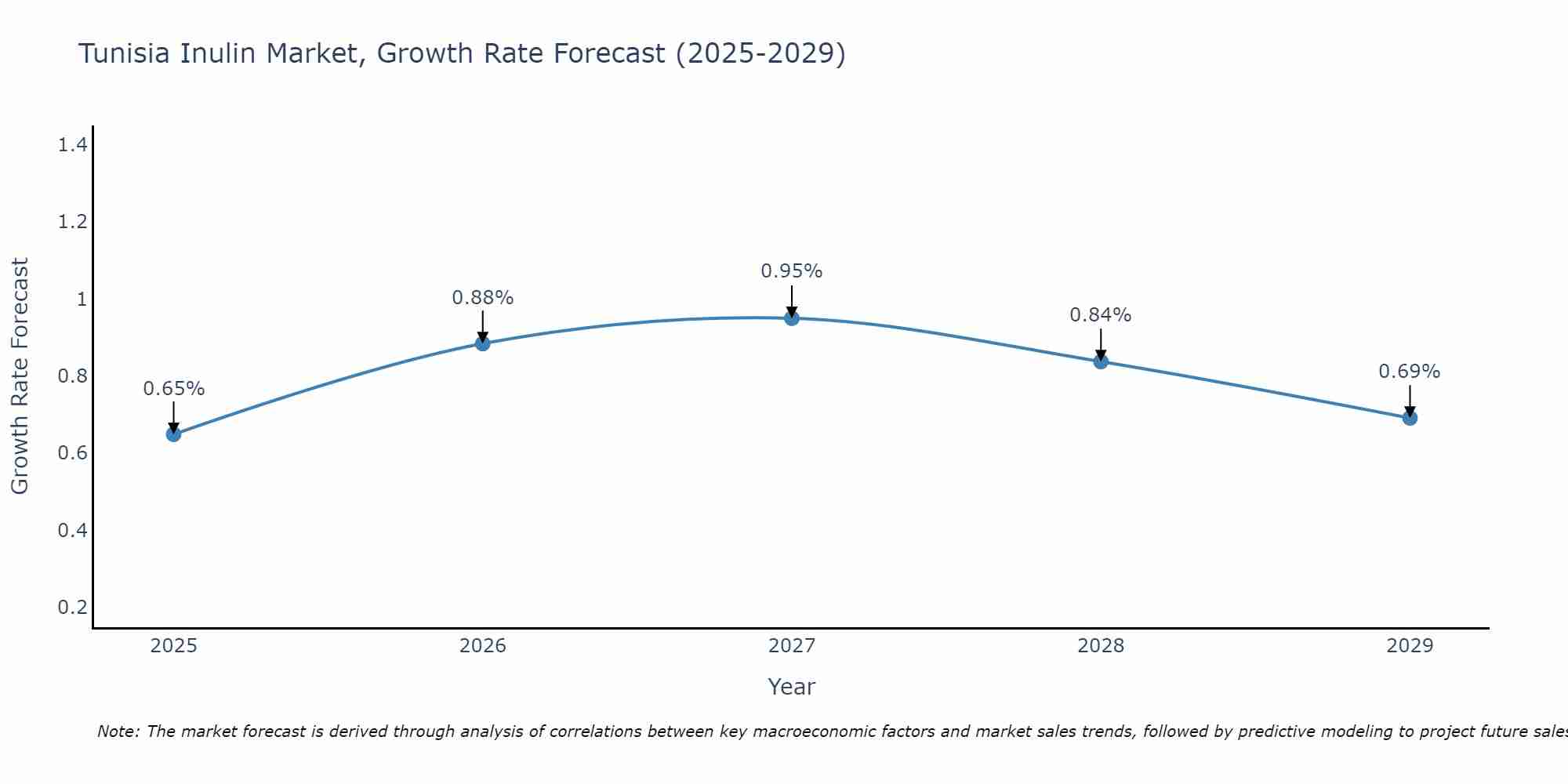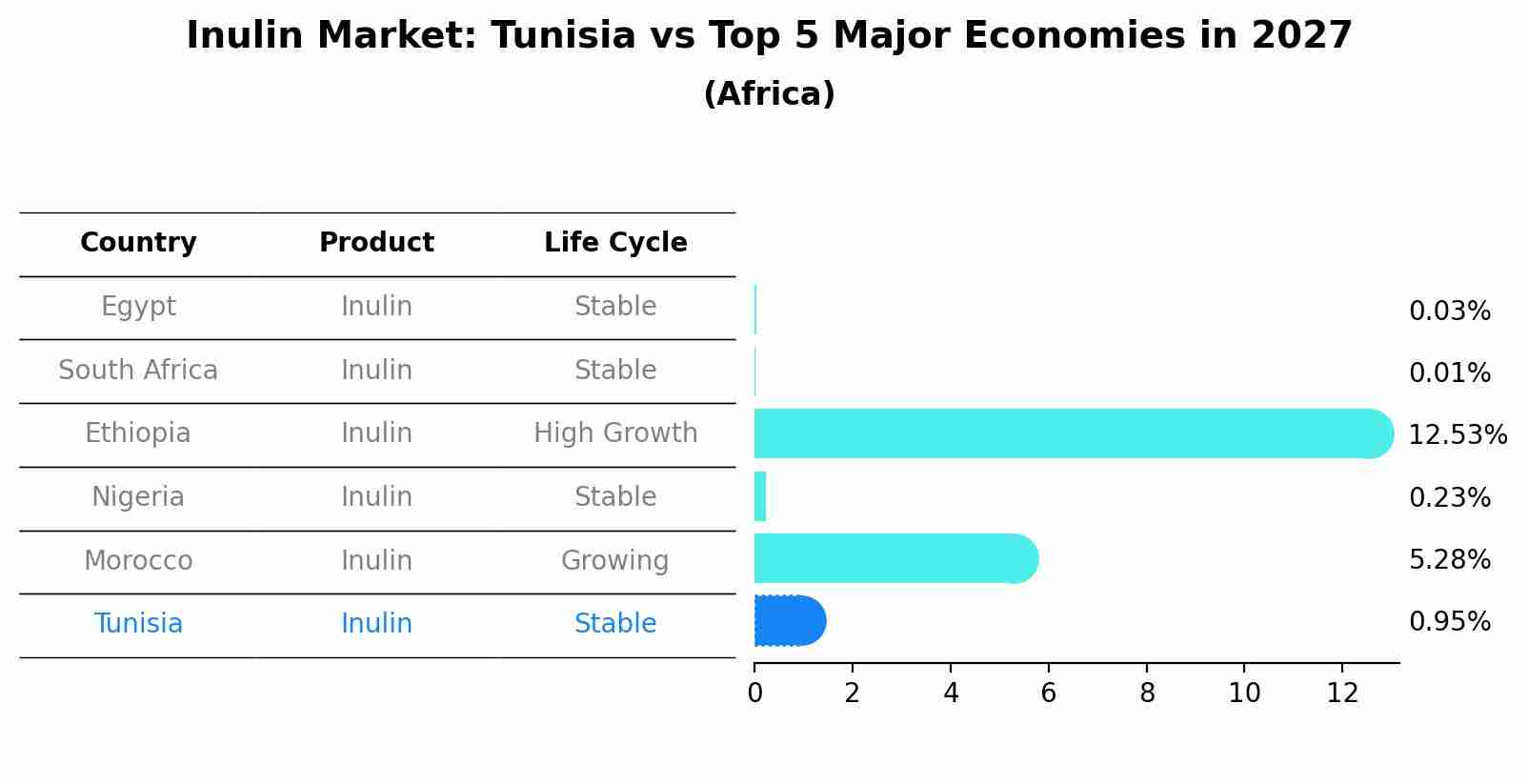Tunisia Inulin Market (2025 - 2031) | Companies, Trends, Share, Industry, Revenue, Forecast, Analysis, COVID-19 IMPACT, Value, Growth & Size
| Product Code: ETC179953 | Publication Date: Jan 2022 | Updated Date: Aug 2025 | Product Type: Market Research Report | |
| Publisher: 6Wresearch | Author: Ravi Bhandari | No. of Pages: 70 | No. of Figures: 35 | No. of Tables: 5 |
Tunisia Inulin Market Size Growth Rate
The Tunisia Inulin Market is projected to witness mixed growth rate patterns during 2025 to 2029. Starting at 0.65% in 2025, the market peaks at 0.95% in 2027, and settles at 0.69% by 2029.

Inulin Market: Tunisia vs Top 5 Major Economies in 2027 (Africa)
In the Africa region, the Inulin market in Tunisia is projected to expand at a stable growth rate of 0.95% by 2027. The largest economy is Egypt, followed by South Africa, Ethiopia, Nigeria and Morocco.

Tunisia Inulin Market Overview
Tunisia`s inulin market is witnessing growth with applications in food and beverage industries, focusing on natural dietary fibers, prebiotic properties, and functional ingredients for digestive health and sugar reduction in food products. Market dynamics include consumer awareness of health benefits, clean label trends, and regulatory approvals for dietary supplements.
Drivers of the market
The inulin market in Tunisia is growing with functional foods, dietary supplements, and natural sweeteners that require inulin fiber derived from chicory roots. Inulin serves as a prebiotic fiber, supporting digestive health, blood sugar management, and weight management benefits. Demand for soluble dietary fibers, low-calorie sweeteners, and clean label ingredients drives inulin adoption in food and beverage formulations, catering to consumer preferences for healthy, natural, and functional food products.
Challenges of the market
The Inulin market in Tunisia encounters challenges related to agricultural production and market competitiveness. Cultivating and processing inulin-rich crops for dietary supplements and food ingredients requires addressing agricultural sustainability and market demand fluctuations. Moreover, ensuring product quality and regulatory compliance influence market acceptance and export opportunities in the global dietary fiber market.
Government Policy of the market
Policies encourage sustainable agriculture practices for inulin production, promoting research and development in agricultural technologies and market access for Tunisian farmers.
Key Highlights of the Report:
- Tunisia Inulin Market Outlook
- Market Size of Tunisia Inulin Market, 2024
- Forecast of Tunisia Inulin Market, 2031
- Historical Data and Forecast of Tunisia Inulin Revenues & Volume for the Period 2021-2031
- Tunisia Inulin Market Trend Evolution
- Tunisia Inulin Market Drivers and Challenges
- Tunisia Inulin Price Trends
- Tunisia Inulin Porter's Five Forces
- Tunisia Inulin Industry Life Cycle
- Historical Data and Forecast of Tunisia Inulin Market Revenues & Volume By Form for the Period 2021-2031
- Historical Data and Forecast of Tunisia Inulin Market Revenues & Volume By Powder for the Period 2021-2031
- Historical Data and Forecast of Tunisia Inulin Market Revenues & Volume By Liquid for the Period 2021-2031
- Historical Data and Forecast of Tunisia Inulin Market Revenues & Volume By Nature for the Period 2021-2031
- Historical Data and Forecast of Tunisia Inulin Market Revenues & Volume By Organic for the Period 2021-2031
- Historical Data and Forecast of Tunisia Inulin Market Revenues & Volume By Conventional for the Period 2021-2031
- Historical Data and Forecast of Tunisia Inulin Market Revenues & Volume By Source for the Period 2021-2031
- Historical Data and Forecast of Tunisia Inulin Market Revenues & Volume By Agave for the Period 2021-2031
- Historical Data and Forecast of Tunisia Inulin Market Revenues & Volume By Chicory for the Period 2021-2031
- Historical Data and Forecast of Tunisia Inulin Market Revenues & Volume By Jerusalem Artichoke for the Period 2021-2031
- Historical Data and Forecast of Tunisia Inulin Market Revenues & Volume By Others for the Period 2021-2031
- Historical Data and Forecast of Tunisia Inulin Market Revenues & Volume By Application for the Period 2021-2031
- Historical Data and Forecast of Tunisia Inulin Market Revenues & Volume By Food & Beverages for the Period 2021-2031
- Historical Data and Forecast of Tunisia Inulin Market Revenues & Volume By Dietary Supplements for the Period 2021-2031
- Historical Data and Forecast of Tunisia Inulin Market Revenues & Volume By Pharmaceuticals for the Period 2021-2031
- Historical Data and Forecast of Tunisia Inulin Market Revenues & Volume By Animal Feed for the Period 2021-2031
- Tunisia Inulin Import Export Trade Statistics
- Market Opportunity Assessment By Form
- Market Opportunity Assessment By Nature
- Market Opportunity Assessment By Source
- Market Opportunity Assessment By Application
- Tunisia Inulin Top Companies Market Share
- Tunisia Inulin Competitive Benchmarking By Technical and Operational Parameters
- Tunisia Inulin Company Profiles
- Tunisia Inulin Key Strategic Recommendations
Frequently Asked Questions About the Market Study (FAQs):
1 Executive Summary |
2 Introduction |
2.1 Key Highlights of the Report |
2.2 Report Description |
2.3 Market Scope & Segmentation |
2.4 Research Methodology |
2.5 Assumptions |
3 Tunisia Inulin Market Overview |
3.1 Tunisia Country Macro Economic Indicators |
3.2 Tunisia Inulin Market Revenues & Volume, 2021 & 2031F |
3.3 Tunisia Inulin Market - Industry Life Cycle |
3.4 Tunisia Inulin Market - Porter's Five Forces |
3.5 Tunisia Inulin Market Revenues & Volume Share, By Form, 2021 & 2031F |
3.6 Tunisia Inulin Market Revenues & Volume Share, By Nature, 2021 & 2031F |
3.7 Tunisia Inulin Market Revenues & Volume Share, By Source, 2021 & 2031F |
3.8 Tunisia Inulin Market Revenues & Volume Share, By Application, 2021 & 2031F |
4 Tunisia Inulin Market Dynamics |
4.1 Impact Analysis |
4.2 Market Drivers |
4.2.1 Increasing consumer awareness regarding the health benefits of inulin |
4.2.2 Growing demand for natural and plant-based ingredients in food and beverage industry |
4.2.3 Rising prevalence of lifestyle diseases such as obesity and diabetes, driving the demand for low-calorie sweeteners like inulin |
4.3 Market Restraints |
4.3.1 Fluctuating prices of raw materials used in inulin production |
4.3.2 Lack of standardized regulations and quality control measures in the inulin market |
4.3.3 Limited availability of inulin sources leading to supply chain challenges |
5 Tunisia Inulin Market Trends |
6 Tunisia Inulin Market, By Types |
6.1 Tunisia Inulin Market, By Form |
6.1.1 Overview and Analysis |
6.1.2 Tunisia Inulin Market Revenues & Volume, By Form, 2021-2031F |
6.1.3 Tunisia Inulin Market Revenues & Volume, By Powder, 2021-2031F |
6.1.4 Tunisia Inulin Market Revenues & Volume, By Liquid, 2021-2031F |
6.2 Tunisia Inulin Market, By Nature |
6.2.1 Overview and Analysis |
6.2.2 Tunisia Inulin Market Revenues & Volume, By Organic, 2021-2031F |
6.2.3 Tunisia Inulin Market Revenues & Volume, By Conventional, 2021-2031F |
6.3 Tunisia Inulin Market, By Source |
6.3.1 Overview and Analysis |
6.3.2 Tunisia Inulin Market Revenues & Volume, By Agave, 2021-2031F |
6.3.3 Tunisia Inulin Market Revenues & Volume, By Chicory, 2021-2031F |
6.3.4 Tunisia Inulin Market Revenues & Volume, By Jerusalem Artichoke, 2021-2031F |
6.3.5 Tunisia Inulin Market Revenues & Volume, By Others, 2021-2031F |
6.4 Tunisia Inulin Market, By Application |
6.4.1 Overview and Analysis |
6.4.2 Tunisia Inulin Market Revenues & Volume, By Food & Beverages, 2021-2031F |
6.4.3 Tunisia Inulin Market Revenues & Volume, By Dietary Supplements, 2021-2031F |
6.4.4 Tunisia Inulin Market Revenues & Volume, By Pharmaceuticals, 2021-2031F |
6.4.5 Tunisia Inulin Market Revenues & Volume, By Animal Feed, 2021-2031F |
7 Tunisia Inulin Market Import-Export Trade Statistics |
7.1 Tunisia Inulin Market Export to Major Countries |
7.2 Tunisia Inulin Market Imports from Major Countries |
8 Tunisia Inulin Market Key Performance Indicators |
8.1 Consumer adoption rate of inulin-containing products |
8.2 Number of new product launches containing inulin |
8.3 Research and development investment in inulin-based products |
9 Tunisia Inulin Market - Opportunity Assessment |
9.1 Tunisia Inulin Market Opportunity Assessment, By Form, 2021 & 2031F |
9.2 Tunisia Inulin Market Opportunity Assessment, By Nature, 2021 & 2031F |
9.3 Tunisia Inulin Market Opportunity Assessment, By Source, 2021 & 2031F |
9.4 Tunisia Inulin Market Opportunity Assessment, By Application, 2021 & 2031F |
10 Tunisia Inulin Market - Competitive Landscape |
10.1 Tunisia Inulin Market Revenue Share, By Companies, 2024 |
10.2 Tunisia Inulin Market Competitive Benchmarking, By Operating and Technical Parameters |
11 Company Profiles |
12 Recommendations |
13 Disclaimer |
- Single User License$ 1,995
- Department License$ 2,400
- Site License$ 3,120
- Global License$ 3,795
Search
Related Reports
- ASEAN Bearings Market (2025-2031) | Strategy, Consumer Insights, Analysis, Investment Trends, Opportunities, Growth, Size, Share, Industry, Revenue, Segments, Value, Segmentation, Supply, Forecast, Restraints, Outlook, Competition, Drivers, Trends, Demand, Pricing Analysis, Competitive, Strategic Insights, Companies, Challenges
- Europe Flooring Market (2025-2031) | Outlook, Share, Industry, Trends, Forecast, Companies, Revenue, Size, Analysis, Growth & Value
- Saudi Arabia Manlift Market (2025-2031) | Outlook, Size, Growth, Trends, Companies, Industry, Revenue, Value, Share, Forecast & Analysis
- Uganda Excavator, Crane, and Wheel Loaders Market (2025-2031) | Strategy, Consumer Insights, Analysis, Investment Trends, Opportunities, Growth, Size, Share, Industry, Revenue, Segments, Value, Segmentation, Supply, Forecast, Restraints, Outlook, Competition, Drivers, Trends, Demand, Pricing Analysis, Competitive, Strategic Insights, Companies, Challenges
- Rwanda Excavator, Crane, and Wheel Loaders Market (2025-2031) | Strategy, Consumer Insights, Analysis, Investment Trends, Opportunities, Growth, Size, Share, Industry, Revenue, Segments, Value, Segmentation, Supply, Forecast, Restraints, Outlook, Competition, Drivers, Trends, Demand, Pricing Analysis, Competitive, Strategic Insights, Companies, Challenges
- Kenya Excavator, Crane, and Wheel Loaders Market (2025-2031) | Strategy, Consumer Insights, Analysis, Investment Trends, Opportunities, Growth, Size, Share, Industry, Revenue, Segments, Value, Segmentation, Supply, Forecast, Restraints, Outlook, Competition, Drivers, Trends, Demand, Pricing Analysis, Competitive, Strategic Insights, Companies, Challenges
- Angola Excavator, Crane, and Wheel Loaders Market (2025-2031) | Strategy, Consumer Insights, Analysis, Investment Trends, Opportunities, Growth, Size, Share, Industry, Revenue, Segments, Value, Segmentation, Supply, Forecast, Restraints, Outlook, Competition, Drivers, Trends, Demand, Pricing Analysis, Competitive, Strategic Insights, Companies, Challenges
- Israel Intelligent Transport System Market (2025-2031) | Strategy, Consumer Insights, Analysis, Investment Trends, Opportunities, Growth, Size, Share, Industry, Revenue, Segments, Value, Segmentation, Supply, Forecast, Restraints, Outlook, Competition, Drivers, Trends, Demand, Pricing Analysis, Competitive, Strategic Insights, Companies, Challenges
- Uganda Precast and Aggregate Market (2025-2031) | Strategy, Consumer Insights, Analysis, Investment Trends, Opportunities, Growth, Size, Share, Industry, Revenue, Segments, Value, Segmentation, Supply, Forecast, Restraints, Outlook, Competition, Drivers, Trends, Demand, Pricing Analysis, Competitive, Strategic Insights, Companies, Challenges
- Australia IT Asset Disposal Market (2025-2031) | Strategy, Consumer Insights, Analysis, Investment Trends, Opportunities, Growth, Size, Share, Industry, Revenue, Segments, Value, Segmentation, Supply, Forecast, Restraints, Outlook, Competition, Drivers, Trends, Demand, Pricing Analysis, Competitive, Strategic Insights, Companies, Challenges
Industry Events and Analyst Meet
Our Clients
Whitepaper
- Middle East & Africa Commercial Security Market Click here to view more.
- Middle East & Africa Fire Safety Systems & Equipment Market Click here to view more.
- GCC Drone Market Click here to view more.
- Middle East Lighting Fixture Market Click here to view more.
- GCC Physical & Perimeter Security Market Click here to view more.
6WResearch In News
- Doha a strategic location for EV manufacturing hub: IPA Qatar
- Demand for luxury TVs surging in the GCC, says Samsung
- Empowering Growth: The Thriving Journey of Bangladesh’s Cable Industry
- Demand for luxury TVs surging in the GCC, says Samsung
- Video call with a traditional healer? Once unthinkable, it’s now common in South Africa
- Intelligent Buildings To Smooth GCC’s Path To Net Zero













